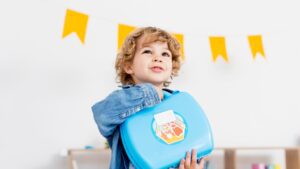
Why Toddlers Hit
If your 2- or 3-year-old has started hitting, you’re not alone—and you’re not a bad parent. At Love2Learn, we see this behavior often in early childhood, and we want to reassure you: it’s a normal (though frustrating) part of development. The key is knowing why it’s happening and how to respond calmly and effectively.
At this age, children are just beginning to learn how to express big feelings. Their verbal skills are still developing, and they don’t yet have the tools to say, “I’m mad,” or “I need space.” So instead, they might use their bodies by hitting, biting, or throwing.
Hitting often happens when a child is:
- Overstimulated or overtired
- Frustrated by a peer or situation
- Seeking attention
- Trying to communicate a need (like “That’s mine!” or “Stop!”)
How We Respond at Love2Learn
At Love2Learn, we approach hitting with calm, clear boundaries and supportive guidance. One of the most effective strategies we’ve found is teaching children to **ask for space**. In many cases, children hit because they feel that someone is too close to them, or another child is reaching for their toys or materials. We coach our students to use their words and advocate for themselves by saying, “I need space,” or “I’m still using that.”
If a child doesn’t feel heard or continues to feel overwhelmed, we encourage them to ask a teacher for help. While we empower children to handle conflicts when possible, we always make it clear that **violence is never the answer**.
Here’s what else we do when a child hits:
- **Stay Calm** – We model the self-regulation we want to see.
- **Set the Boundary** – We say: “I won’t let you hit. Hitting hurts.”
- **Offer Words or Alternatives** – “You can say, ‘Please stop,’ or ‘I need space.’”
- **Coach the Repair** – If appropriate, we guide the child in checking on their peer and making amends.
Tips for Parents at Home
You can support your child’s social-emotional development with these simple strategies:
- Use clear, calm language: “No hitting. Hitting hurts.”
- Name the emotion: “You’re mad. It’s okay to be mad, but we don’t hit.”
- Practice using phrases like: “I need space,” or “I’m not done with that.”
- Reinforce asking for help when needed.
Remember—toddlers are still learning. You may have to repeat the same message repeatedly, but it builds emotional literacy and self-control over time.
When to Seek Support
If the hitting becomes frequent or seems unusually intense, it could be a sign that your child needs additional support. Sometimes hitting is tied to sensory processing, speech delays, or other developmental needs. We’re here to help—Love2Learn works in partnership with families to observe, reflect, and create responsive plans for behavior.
You’re Not Alone
Raising toddlers takes patience, consistency, and a lot of love. At Love2Learn, we’re here to walk alongside you with strategies that are rooted in empathy and respect.
Schedule a Tour at Love2Learn
Want to learn more about our approach to behavior and social-emotional growth? Schedule a tour at Love2Learn Early Learning Center in Mechanicsburg, PA today.
References
Center on the Social and Emotional Foundations for Early Learning (CSEFEL). (n.d.). Teaching children to manage their own behavior. Vanderbilt University.
Zero to Three. (n.d.). Aggression in toddlers: What it means and what to do. Retrieved April 15, 2025, from
National Association for the Education of Young Children (NAEYC). (n.d.). Supporting social and emotional development through positive guidance.
Shanker, S. (2016). Self-reg: How to help your child (and you) break the stress cycle and successfully engage with life. Penguin Books.
Teti, D. M., Kim, B. R., Mayer, G., & Countermine, M. (2010). Maternal emotional availability at bedtime predicts infant sleep quality. Journal of Family Psychology, 24(3), 307–315.





